| |


|
THE FIRST BARS |
THE FAMOUS LONG BAR |
THE DINING ROOM |
|
THE QUIGLEY RESIDENCE
|
THE GIFT SHOP
|
|
| |
|
|

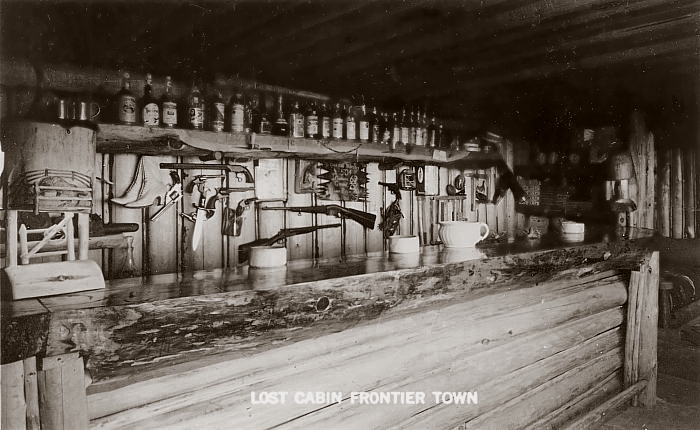
The
first Frontier Town bar, 1948.

Detail
of the back-bar, 1948.

Sue
Quigley behind the original Frontier Town bar, early 1950s.

John
Quigley tending bar, early 1950s. Patron unidentified.

A
second bar, 1950s. The exact location this bar occupied is
now unknown.


|
ACTION-PACKED
ATTRACTION
The
50' long bar, made from a single huge Douglas Fir
tree split down the middle, was undoubtedly the main
attraction at Frontier Town. It featured real saddles
for seats and a large three-dimensional diorama across
the back bar, with numerous little figures and models
which guests could animate by feeding coins into handy
mechanisms. Featured "shows" were a soaring
eagle, a model stagecoach which ran the length of
the back bar, an Indian buffalo-jump with smoke signals,
and an Indian war dance -- complete with snapping
and popping sounds of tiny rifles.
Water
for mixed drinks came from a natural mountainside
spring which John Quigley piped through part of the
diorama, forming a waterfall. Unfortunately, only
a small number of diorama photographs are known exist.
At
the north end of the bar was a cozy and popular fireplace
nook, near the stone steps leading up to the dining
room.
Also
at that end of the bar was a small bronze sculpture
of a cowboy cooking a meal over a tiny gas-flame campfire.
When a curious visitor peered into the cowpoke's frying
pan, a bartender would remotely tigger a jet of ice-cold
water to shoot from the cowboy's mouth, splashing
first against a flat rock, then into the face of the
victim.
In
short, the scene at the bar was always action-packed.
|
|
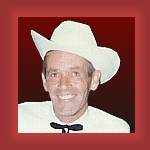
THE STORY OF THE LONG BAR IN JOHN QUIGLEY'S OWN
WORDS...
FROM A 1960s PROMOTIONAL BOOKLET
"Construction
of the saloon was done in the winter of 1951 and the
spring of 1952. From that time on (and with many more
future plans) I have worked out the various carvings,
dioramas, model animals, stagecoaches, covered wagons
and figures to be found throughout the bar. The bar
itself it made of Douglas Fir, fifty feet, six inxhes
long; it weighs six tons and contains twenty-five
hundred board feet of lumber. I split the log during
twenty below zero weather with a chain saw. It took
two days to accomplish. The bottom of the log sits
on stone pillars while the upper half is over head,
held up by log supports from the same tree. The bar
top, which has a mirror-like finish from sanding and
polishing, I did by hand."
"
[There are] eight good riding saddles placed for bar
stools. Hanging from the bottom of the bar to the
floor are cowhides tanned with the hair on. And on
the walls are other hides; buffalo, bear, wolverine
and beaver."
|
1950s
Views of the Long Bar
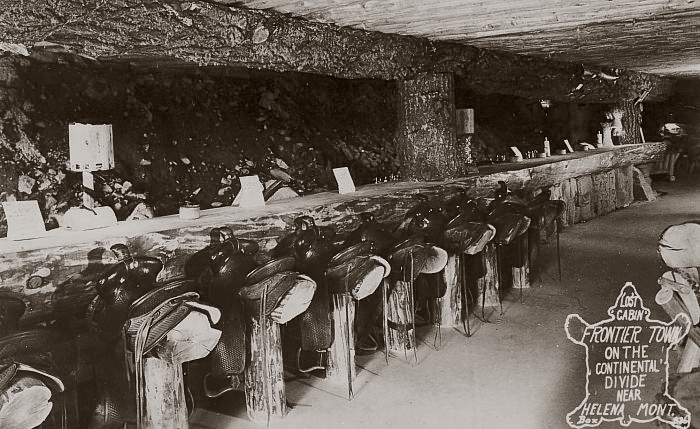
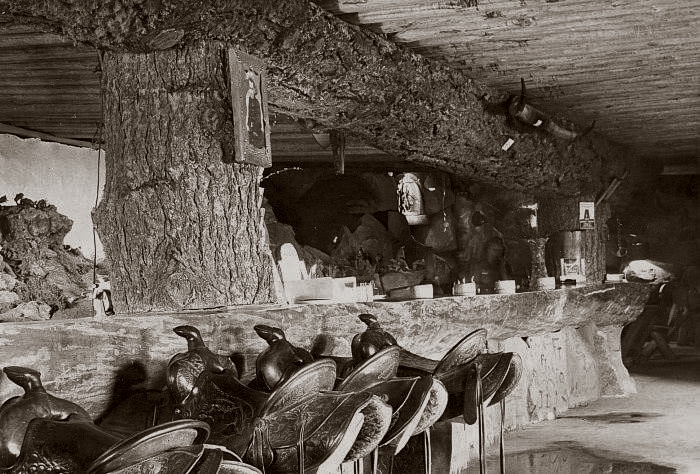
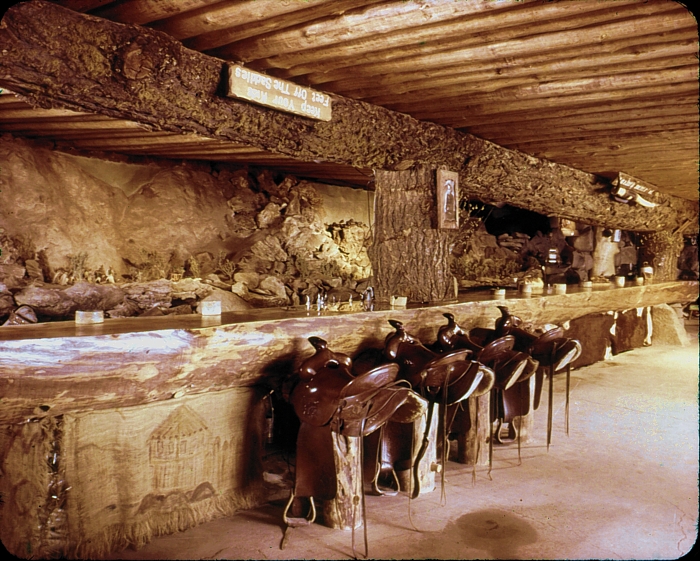
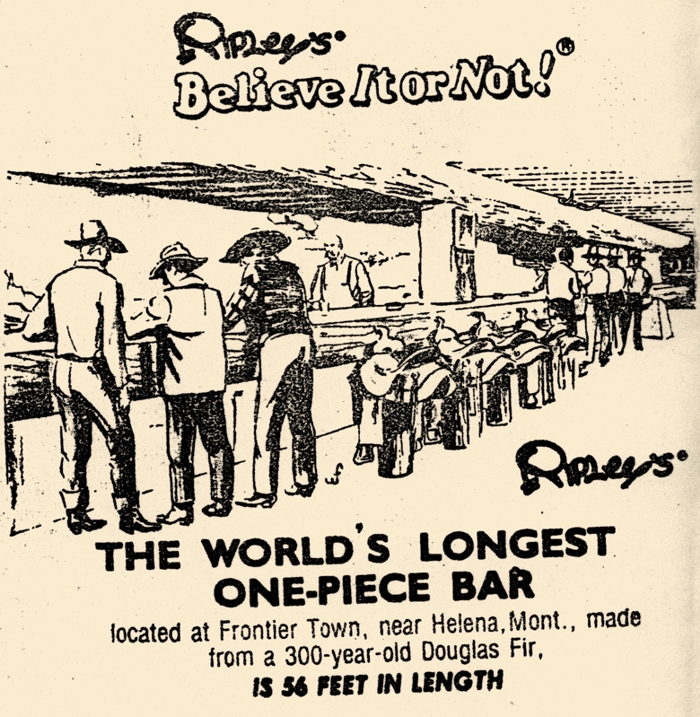
|
The
Animated Back Bar Diorama
"Stand
at the front of the bar and look at the back bar.
You'll see an eagle soaring over the hills and lake
and dipping down among the trees. The eagle was made
by me from a small piece of aluminum foil, suspended
from a silk thread and operated by a small motor counter-sunk
in one of the ceiling logs. The eagle flies 271/2
miles each day; a total of 10,000 miles per year,
someone tells me.
As you look at the miniature lake amidst a setting
of snowcapped mountains, you'll see a fisherman which
I made by building a wire form, covering it with beeswax
and then carving with small knives. If you look closely
you may see tension on his line and a definite bend
in his fishing pole.
From this sparkling lake, supplied with water from
a mountain spring which bubbles up right in the center
of it, you can follow the water down the rocks, under
a miniature bridge and finally over a waterfall between
two huge boulders. From there it runs outside under
the floor. This spring water is ice cold. It is used
in all drinks by placing the glass under the waterfall.
Easy touch, says the barkeep!"

Clipping
from an Independent Record feature on Frontier
Town, Aug. 9, 1953
"On
the hillside to the right of the lake you'll see a
herd of eleven elk. Farther up among the cliffs are
five mountain goats, watching. Elsewhere on this diorama
you may find such animals as a deer, horses,bear,bobcats,
and mountain lions. Everything was carved and molded
into perspective, that, in viewing them, you have
the impression that you are overlooking spacious Montana
scenery -- both nearby and miles away."
"The
trees on the back bar-76 in all—were carefully
selected and cut out of the tops of juniper trees,
then treated in a solution of fcrmaldehyde and glycerine
as a preservative. They were then dipped in paint.
The trunks and limbs were hand-painted to give them
their natural look. (In the prairie regions of Montana
you will find sagebrush and thistle which has been
treated much the same way to enhance its natural look."
|
Views
of the Animated Back Bar Diorama

Arrow
Shot by Expert Archer Howard Hill, 1954
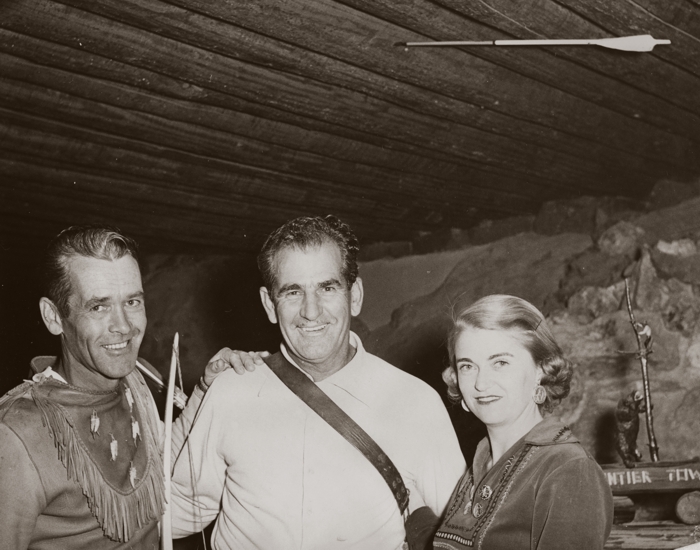
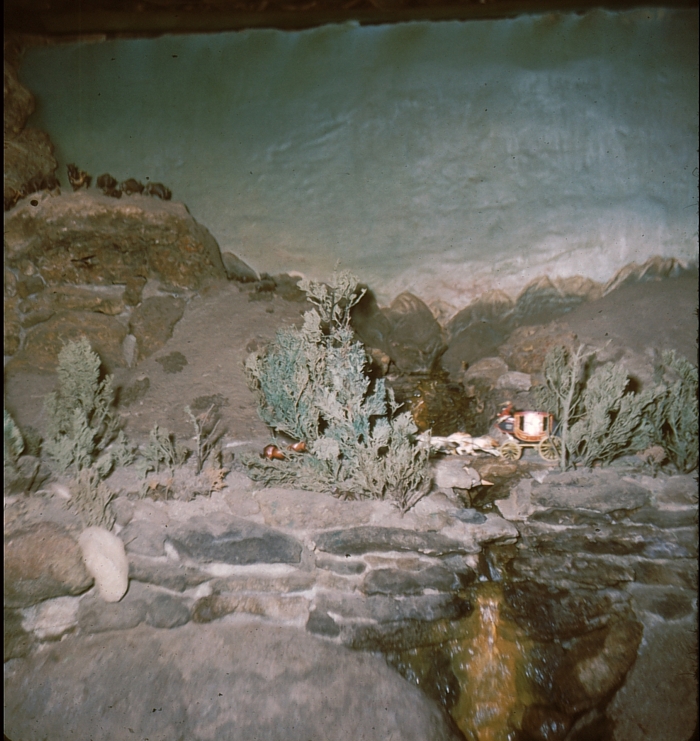
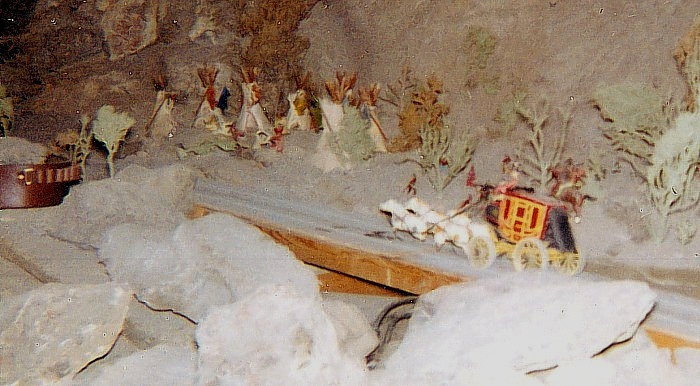
Back
Bar diorama, animated model stagecoach on track, and Indian
village.
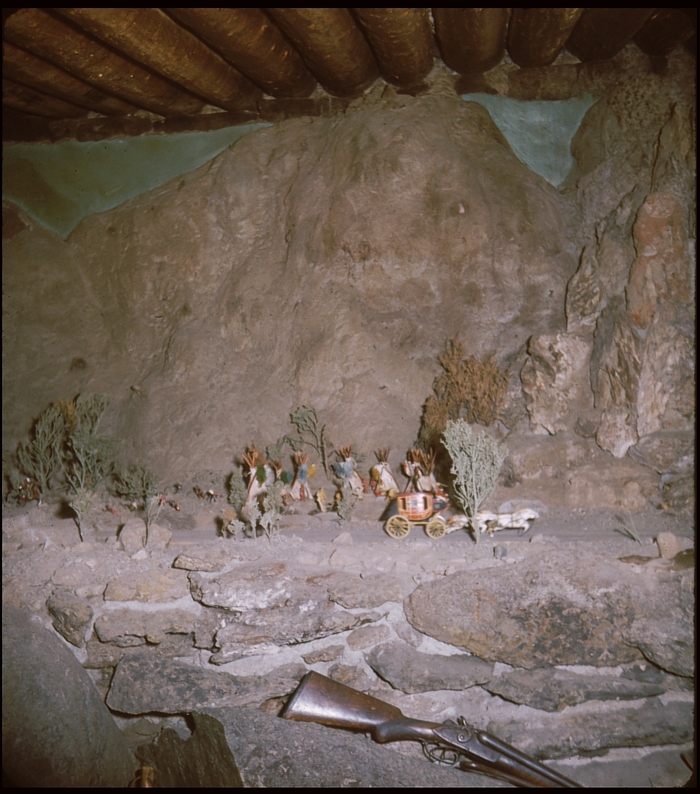
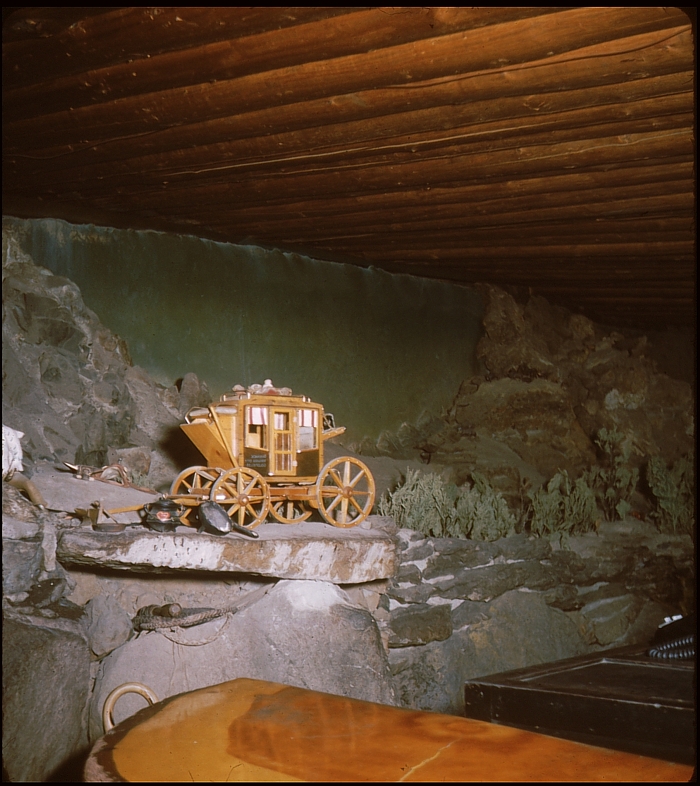
North
End of the Long Bar
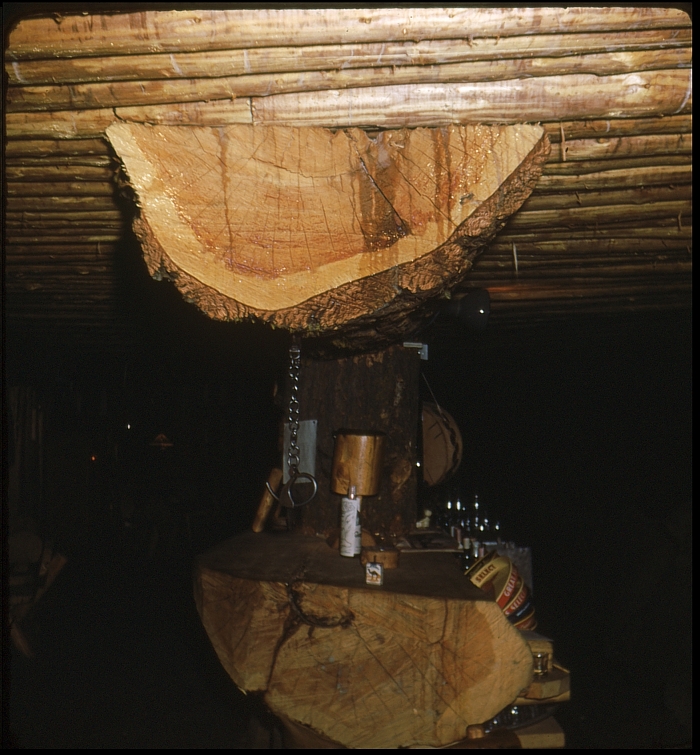
Fireplace
Nook at the End of the Long Bar
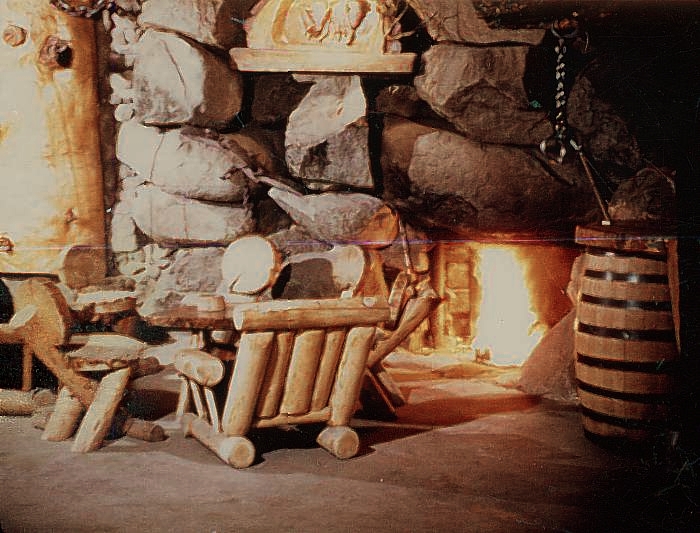
THE
SPITTIN' COWPOKE
| At
the north end of the bar was a a small sculpture
of a cowboy cooking a meal over a tiny gas-flame campfire.
When a curious visitor peered into the cowpoke's frying
pan, a bartender would remotely tigger a jet of ice-cold
water to shoot from the cowboy's mouth, splashing first
against a flat rock, then into the face of the victim,
like the young fellow seen in the photo below... |
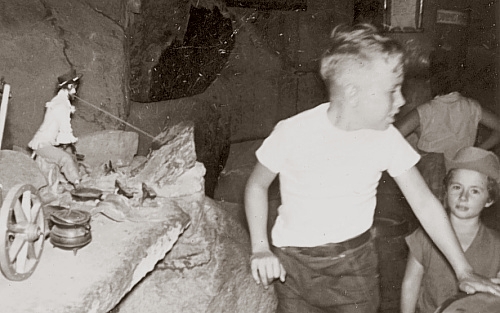

Clipping
from an Independent Record feature on Frontier Town,
Aug. 9, 1953
BEER
BOTTLE LABELS, 1950s
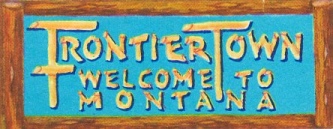

| The
top label was applied to the neck of the bottle. Frontier
Town's "Home Brew" beer was produced by the
historic Kessler Brewing Company, located on Helena's
west side. |
|
John
Quigley Carves the Bar Top, 1956
"You
will find two carvings in the bar top, the first being
two elk fighting over the female protion of the herd.
This I carved during the fall and winter of 1956,
putting in more than 300 hours. The carving of a mountain
lion is on the lower end of the bar in front of the
saddles."
|
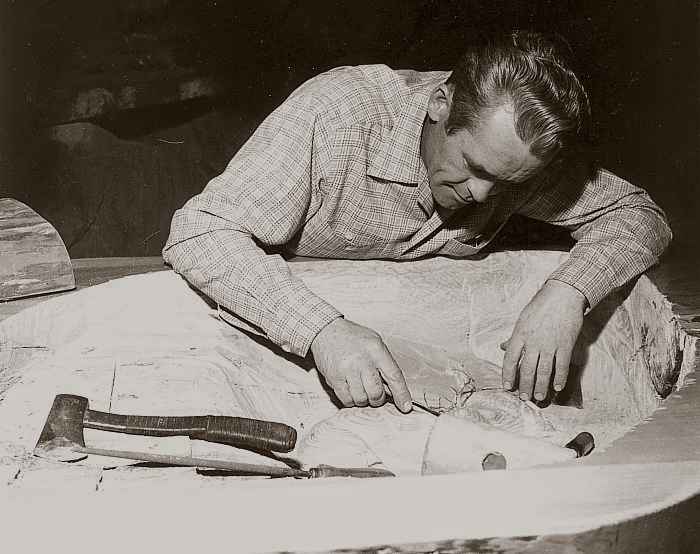

Quigley's
elk carving, 2003.
Doorway
and Steps Leading Up to the Dining Room
ADJACENT
TO THE FIREPLACE NOOK

Looking
Down the Steps



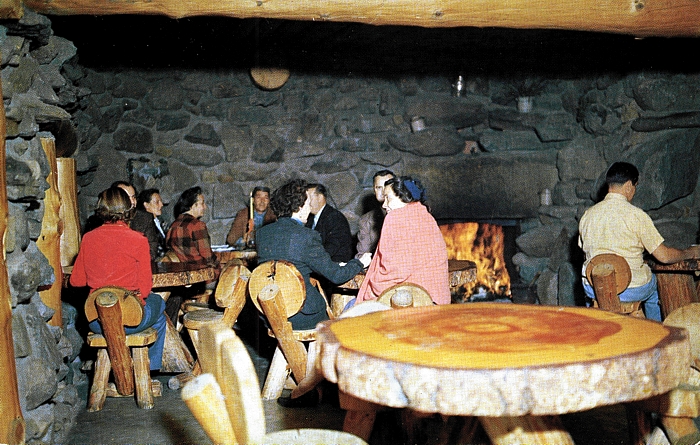
Dining
room, 1951 postcard view.
Independent
Record, Aug. 9 1953
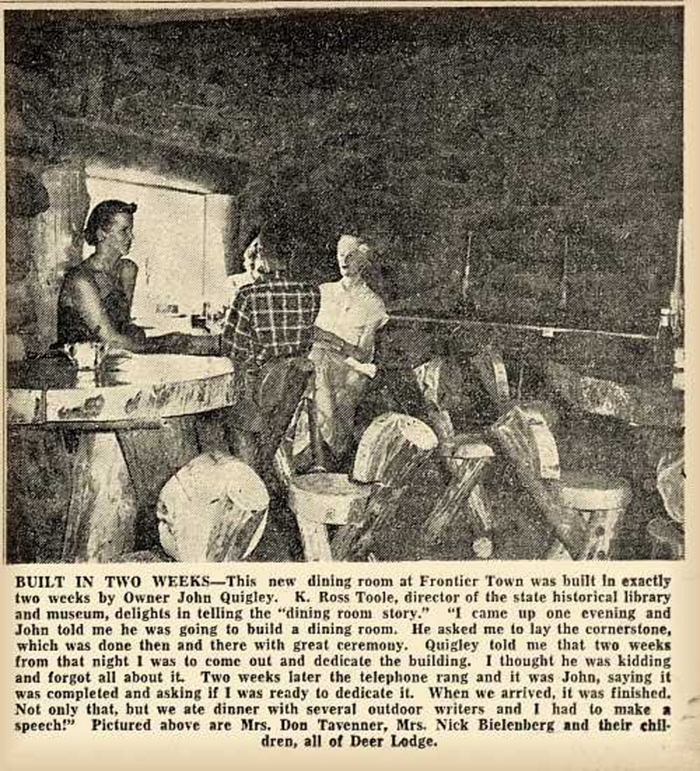

Dining
Room crew, 1955
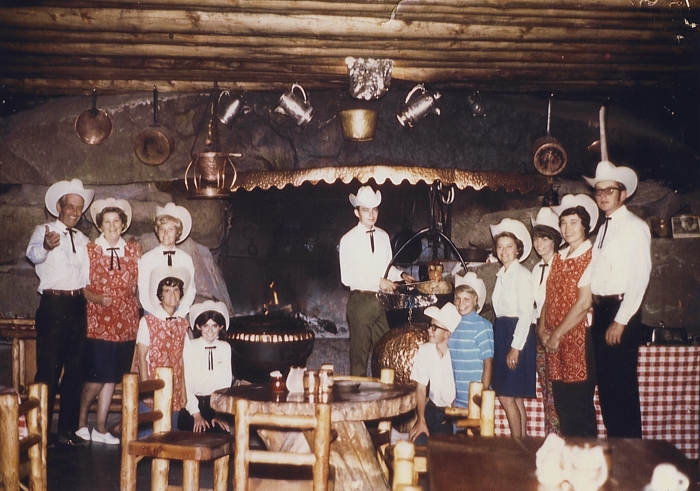
CLICK
TO ENLARGE
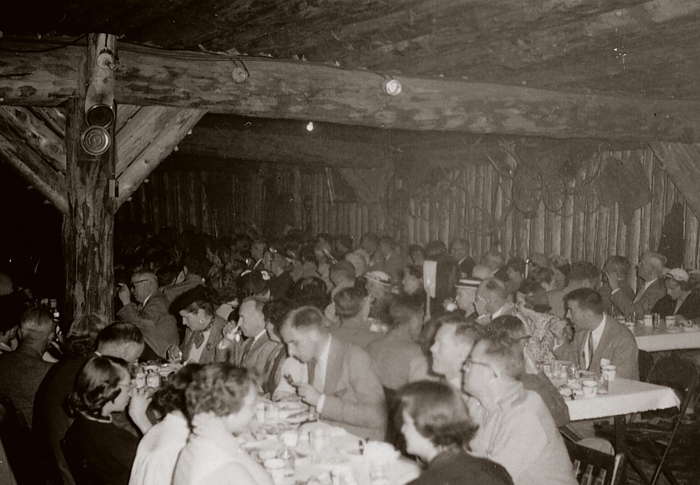
Dining
Room Fireplace, 1950s
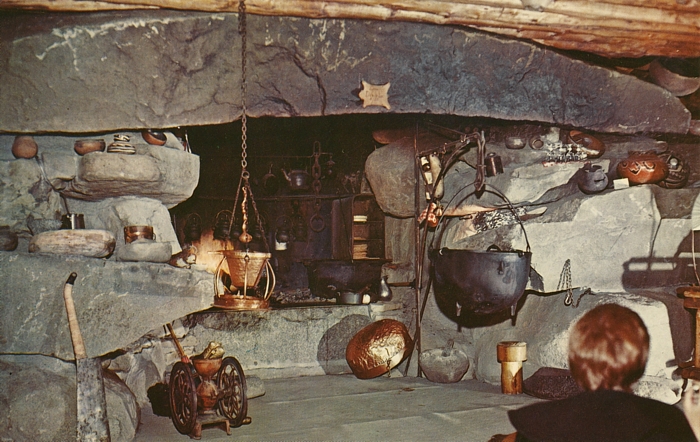
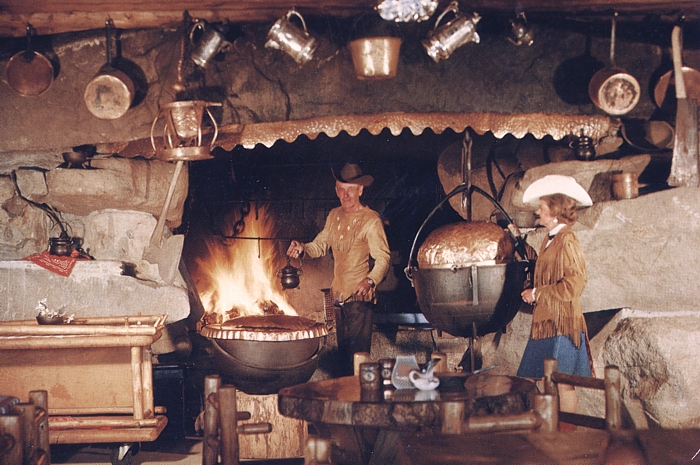
Exterior
Views of the Dining Room
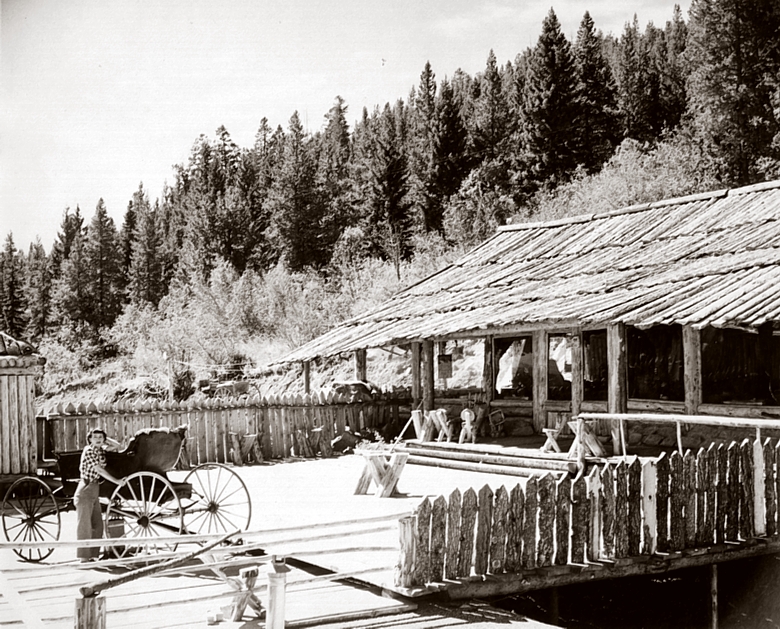
Balcony
Railing Tragedy, 1961

| Mr.
and Mrs. Smidt died of their injuries. Tom Tobin and
Marc Buterbaugh recovered. Buterbaugh brought suit against
Frontier Town. |


Frontier
Town Summer Theatre, 1951 - 1954
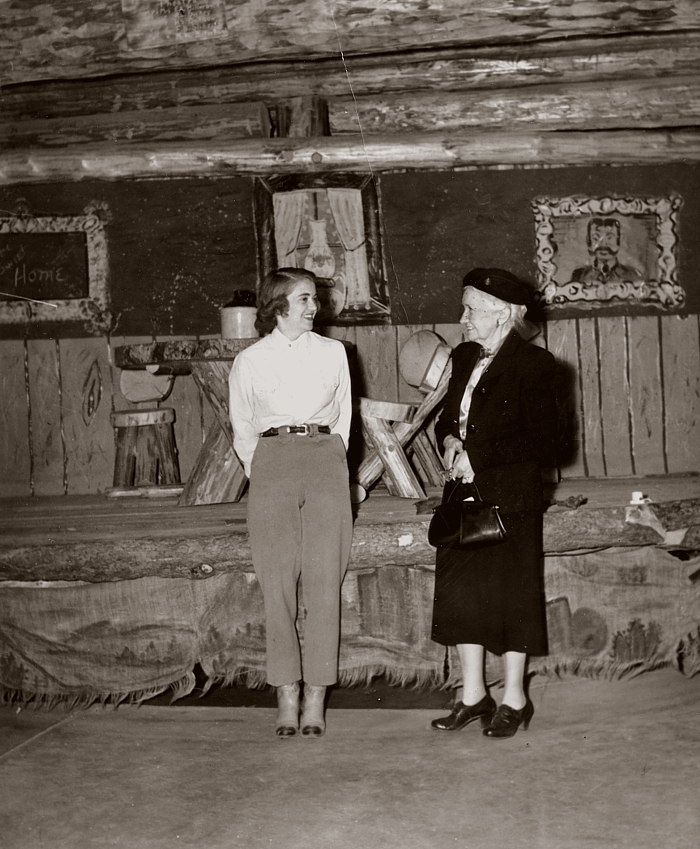
Doris
and Walter Marshall began producing plays -- mainly
melodramas -- at Frontier Town in 1951. In 1953, "Helena,
Unlimited" - a not-for-profit organization spearheaded
by past Chamber of Commerce President H. S. "Hi"
Dotson - purchased the run-down Capital Brewery building
on West Main with the intention of converting it into
a summer playhouse. Using volunteer labor, the Marshalls
oversaw the cleanup and renovation of the Brewery, and
produced several plays there in 1954. They also continued
to produce shows at Frontier Town in '54, but in 1955
they began focusing solely on the Old Brewery Theatre
and The Bandit Players.
The stage at Frontier Town was a heavy, rotating affair,
built of logs by John Quigley. It was located in the
upstairs dining room. Above is a photo of Sue Quigley
and Helen Quigley Price in front of the stage, early
1950s. |
Letter
from Walter Marshall to John and Sue Quigley, 1953
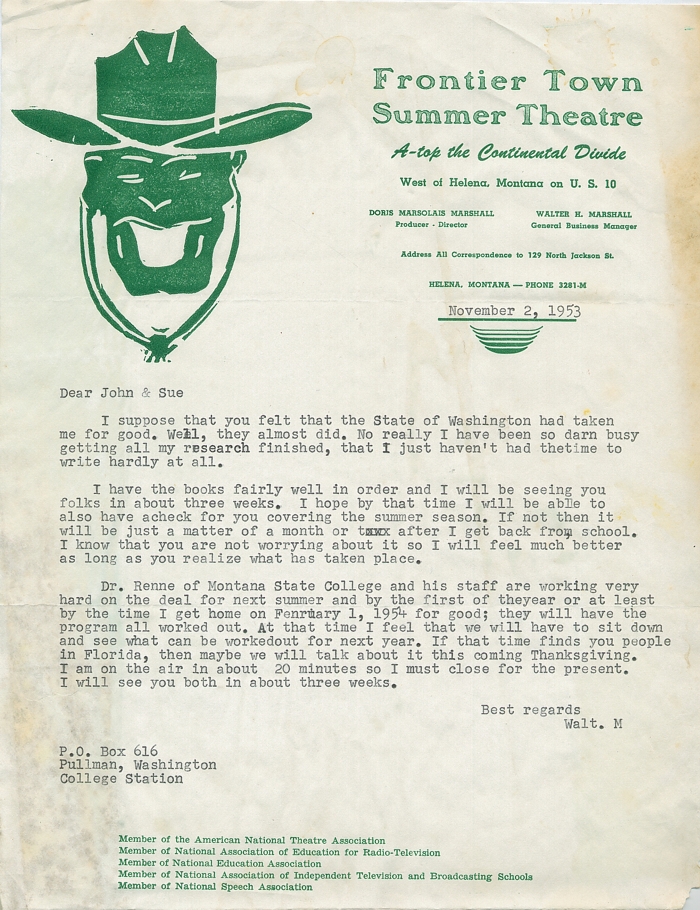
Producter/Director Doris Marshall, ca. 1949
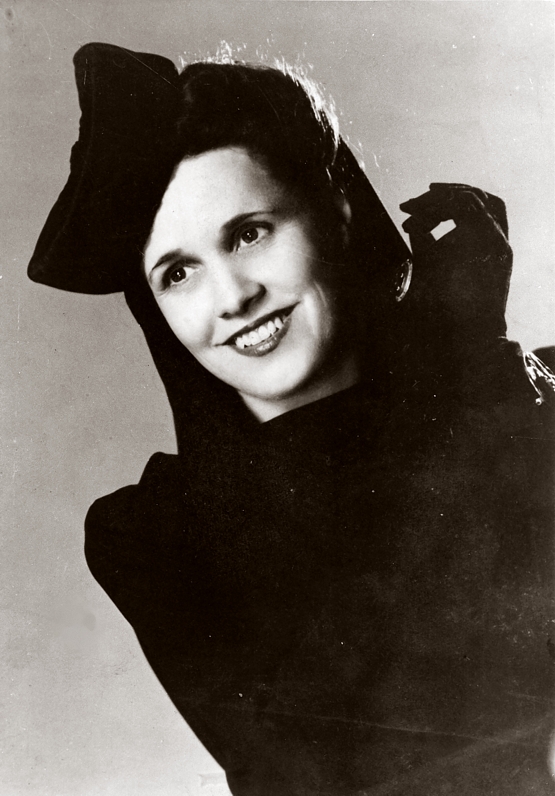

1975
Dining Room Fire

| John
Quigley rebuilt the dining room. The large stone over
the fireplace was split by the heat, and didn't look
the same after the fire. |
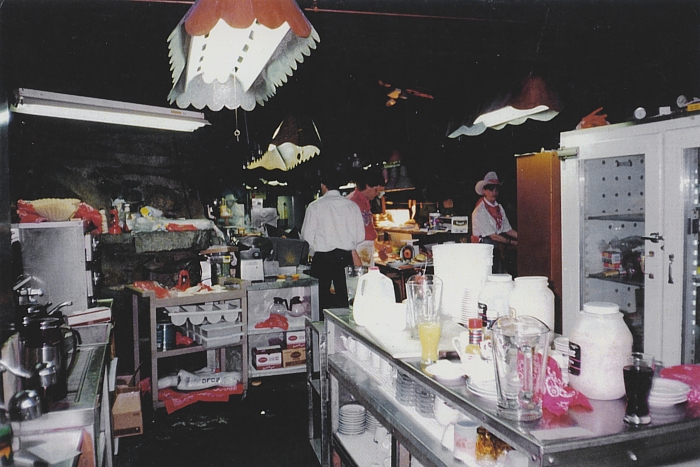
|

|
|